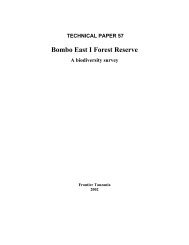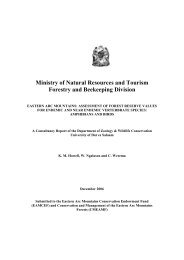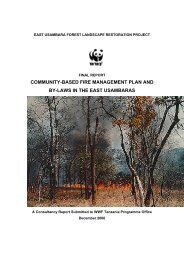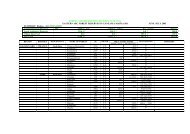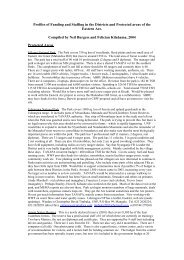Butterfly Farming in the East Usambara Mountains - Eastern Arc ...
Butterfly Farming in the East Usambara Mountains - Eastern Arc ...
Butterfly Farming in the East Usambara Mountains - Eastern Arc ...
You also want an ePaper? Increase the reach of your titles
YUMPU automatically turns print PDFs into web optimized ePapers that Google loves.
1.5.1 Family <strong>Arc</strong>tiidae:<br />
No species names are known for <strong>the</strong>se day fly<strong>in</strong>g months s<strong>in</strong>ce a guide is difficult to locate.<br />
Instead, <strong>the</strong> project has developed common names that apply to each species.<br />
• Irridencent Blue and Orange – Apparently feeds on De<strong>in</strong>bollia burbonica accord<strong>in</strong>g to<br />
<strong>the</strong> Fanusi farm<strong>in</strong>g group. It is usually not seen above 400 meters.<br />
• Tiger Stripe – Feeds on Crotolaria found along rivers and roads. This species is not<br />
common but mostly seen after <strong>the</strong> cold season is over at altitudes from 900 meters to 600<br />
meters.<br />
• Forest – Feeds on Brucea species. It is common year round <strong>in</strong> Amani between 800 and<br />
1000 meters, though it can occationally be seen as low as 600 meters.<br />
• Red and Black with White Spots – Food plant not known, but may be species of small<br />
shrub/herb that <strong>Arc</strong>tiidae larvae have been found on <strong>in</strong> <strong>the</strong> past. James Msuya also knows<br />
<strong>the</strong> plant.<br />
1.5.2 Family Hesperiidae:<br />
• Coeliades chalybe – An iridescent blue skipper. No attempt to breed it has been made. It<br />
is most active <strong>in</strong> <strong>the</strong> early morn<strong>in</strong>g and at dusk. It is found from 300 meters to 900<br />
meters. Kielland reports Cynanchum as a host plant.<br />
1.5.3 Family Nymphalidae:<br />
• Acraea aganice – A large Acraea species that will lay on <strong>the</strong> common species of Adenia<br />
<strong>in</strong> Amani. It is mostly found along rivers from 500 meters up to 900 meters. Shipp<strong>in</strong>g<br />
pupae may be difficult s<strong>in</strong>ce <strong>the</strong> pupa phase lasts from 6 to 7 days.<br />
• Acraea satis – Ano<strong>the</strong>r large Acraea species with <strong>in</strong>terest<strong>in</strong>g translucent patches on <strong>the</strong><br />
w<strong>in</strong>gs. No attempt has been made to breed this species, but females have been witness<br />
apparently lay<strong>in</strong>g eggs on a species of R<strong>in</strong>orea found along rivers <strong>in</strong> <strong>the</strong> Amani area,<br />
where <strong>the</strong> butterfly species is most commonly seen. R<strong>in</strong>orea is listed <strong>in</strong> Kielland as a host<br />
plant for satis.<br />
• Acraea eg<strong>in</strong>a – Ano<strong>the</strong>r large Acraea species found <strong>in</strong> more open areas. It is readily<br />
bread on Adenia. The pupa phase is around 5 days so it may be hard to ship live.<br />
• Amauris niavius – The largest Amauris species <strong>in</strong> <strong>the</strong> Amani area and a very popular<br />
model for mimetic species. The host plant was located through observation of a female <strong>in</strong><br />
<strong>the</strong> wild. The unidentified v<strong>in</strong>e, which must belong to <strong>the</strong> Asclepiadaceae family,<br />
surpris<strong>in</strong>gly does not produce latex. In warm wea<strong>the</strong>r, females readily lay eggs on this<br />
v<strong>in</strong>e <strong>in</strong> shade net cages. This species went from be<strong>in</strong>g one of <strong>the</strong> most commonly seen<br />
species <strong>in</strong> 2002 to almost non-existent <strong>in</strong> <strong>the</strong> first half of 2003. This decl<strong>in</strong>e was not<br />
noticeably seasonal and was likely caused by a large parasite population. The population<br />
7



